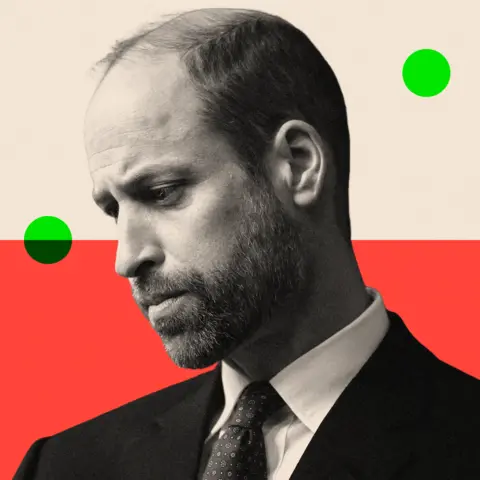
Last year I watched as King Charles and Queen Camilla led the royal party to church on Christmas Day, followed by the Prince and Princess of Wales, holding the hands of their children as they spoke to the crowds.
The Princess kept a firm grip on playful Prince Louis while they were given Christmas cards and presents, along with dozens of flowers.
I could never have predicted that this was the last time we would see her in person for more than six months. I was expecting to head to Italy with the couple on a royal tour, but she wouldn’t join the Royal Family on another official engagement until Trooping the Colour in June.
On 16 January, the Princess of Wales was admitted to hospital for major abdominal surgery. At the end of March, she went public with her cancer diagnosis and chemotherapy.
For her husband, it was the start of a year that he would go on to call “the hardest of his life”.
It throws up memories of Queen Elizabeth’s own “sombre year” of 1992 when there were multiple marriage breakdowns within the family and a major fire. At the time she described it with the now infamous phrase, “annus horribilis”
But it was also a year in which certain aspects of Prince William’s approach were cemented – family came first, the school run was prioritised. For the Prince of Wales, this time of turbulence appears to have reinforced what matters to him most.
Along the way, however, it has also become evident what kind of senior royal William wants to be. We’ve seen more of his apprenticeship as a global statesman, especially during the 80th anniversary of D-Day on a stage alongside world leaders – but the William way has also left some questioning certain choices he has made.
Around this time, the Princess was given the news that cancerous cells had been discovered in post-operative tests.
Over the next three weeks, the couple told the children what was happening and had time to deal with their questions privately before going public.
“I think what was remarkable was just how hard it was for the Prince of Wales at the start of the year,” says a friend of the Prince. “His wife had gone in for major surgery and it became worse than expected. Then there was, ‘How do I tell my three children that Mummy is ill?'”
All of this was happening against the backdrop of the King’s own cancer treatment, which he made public on 5 February.
“At a time when he was trying to protect his wife and children, he had that terrible thought that that if his father dies then everything changes,” says the friend.
Several people who know the Prince personally or have worked with him this year told me that the spotlight on what was wrong with his wife took its toll on both William and Catherine.
“He was having to operate against the backdrop of the entire world questioning what was happening to his wife,” one friend told me.
With his father largely out of action for several weeks and the Princess away from public duty, the royal diary was looking stretched. Prince William was adamant that public duty would have to wait until the situation at home was more settled.
It offered a hint of Prince William’s way of doing things. Yes, he understood that his was a life where duty and service are expected. But for him, a man who had experienced immense loss at a young age, his wife and children were most important of all.
There were two other important factors at home that helped the Prince of Wales support his wife and children – his in-laws, the Middletons; and living in Windsor.
When the Princess made her public announcement about her diagnosis, the message was posted on royal social media accounts, and one of the first people to publicly respond was her brother James.
Alongside a childhood holiday photo of himself and his sister, he wrote: “Over the years, we have climbed many mountains together. As a family, we will climb this one with you too.”
Together with his sister Pippa and parents Carole and Michael, the family became key to keeping life as normal as possible for the royal children. People living locally reported seeing Carole Middleton, who lives 30 miles away in Bucklebury, Berkshire, regularly driving in and out of Windsor Castle.
And when the Princess’s surgery prevented her from driving, it was her mother who often drove her daughter to school to collect the three children.
The decision to move from Kensington Palace to Windsor Castle in 2022 also proved timely.
“Windsor has been a sanctuary. It has provided the protection and privacy the family needed this year,” said a friend
The family live in Adelaide Cottage, a four-bedroom house within the Castle grounds that is secluded enough to give the family freedom that Kensington Palace, which is located in central London, could not.
Snatched photos show the Prince of Wales using an electric scooter to get around the grounds. When on royal duty, he would occasionally reveal a snippet about life at home, such as his continued devotion to Aston Villa FC, or a favoured film or TV series – earlier this year he enjoyed action film The Fall Guy and more recently he and the Princess watched spy thriller series Black Doves on Netflix.
He has also taken his children to football matches at local clubs and both he and the Princess have continued to be part of school life at Lambrook, the private school in Berkshire that their children attend. During her treatment, the Princess was still able to be on the sidelines during sports days.



